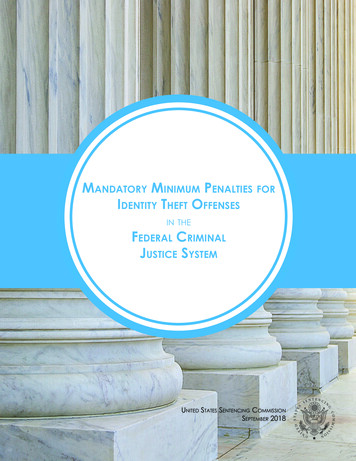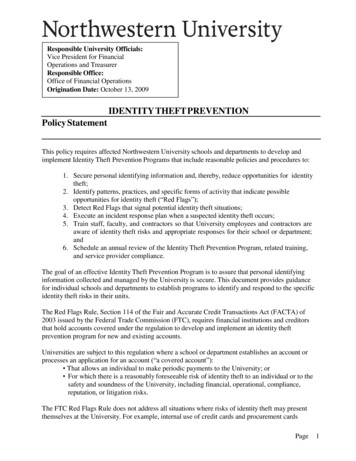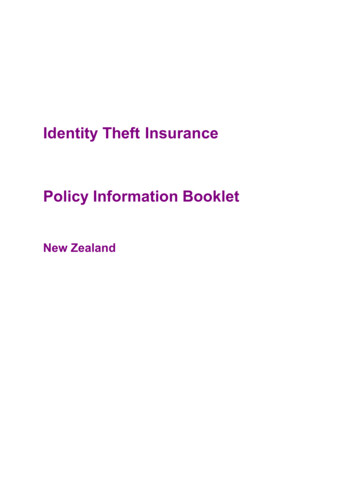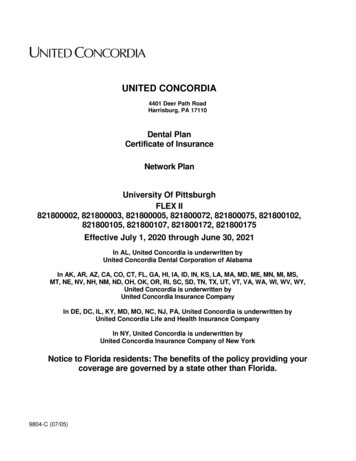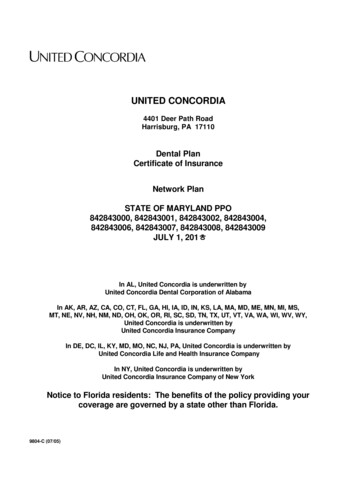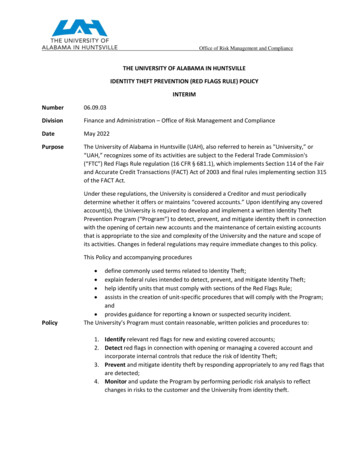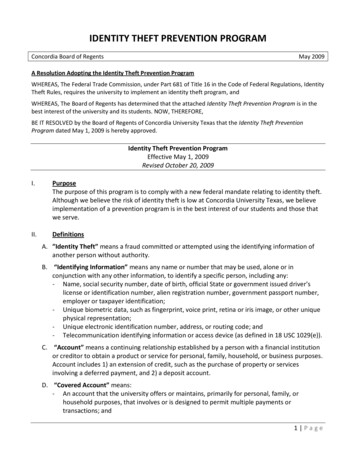
Transcription
IDENTITY THEFT PREVENTION PROGRAMConcordia Board of RegentsMay 2009A Resolution Adopting the Identity Theft Prevention ProgramWHEREAS, The Federal Trade Commission, under Part 681 of Title 16 in the Code of Federal Regulations, IdentityTheft Rules, requires the university to implement an identity theft program, andWHEREAS, The Board of Regents has determined that the attached Identity Theft Prevention Program is in thebest interest of the university and its students. NOW, THEREFORE,BE IT RESOLVED by the Board of Regents of Concordia University Texas that the Identity Theft PreventionProgram dated May 1, 2009 is hereby approved.Identity Theft Prevention ProgramEffective May 1, 2009Revised October 20, 2009I.PurposeThe purpose of this program is to comply with a new federal mandate relating to identity theft.Although we believe the risk of identity theft is low at Concordia University Texas, we believeimplementation of a prevention program is in the best interest of our students and those thatwe serve.II.DefinitionsA. ”Identity Theft” means a fraud committed or attempted using the identifying information ofanother person without authority.B. “Identifying Information” means any name or number that may be used, alone or inconjunction with any other information, to identify a specific person, including any:- Name, social security number, date of birth, official State or government issued driver’slicense or identification number, alien registration number, government passport number,employer or taxpayer identification;- Unique biometric data, such as fingerprint, voice print, retina or iris image, or other uniquephysical representation;- Unique electronic identification number, address, or routing code; and- Telecommunication identifying information or access device (as defined in 18 USC 1029(e)).C. “Account” means a continuing relationship established by a person with a financial institutionor creditor to obtain a product or service for personal, family, household, or business purposes.Account includes 1) an extension of credit, such as the purchase of property or servicesinvolving a deferred payment, and 2) a deposit account.D. “Covered Account” means:- An account that the university offers or maintains, primarily for personal, family, orhousehold purposes, that involves or is designed to permit multiple payments ortransactions; and1 Page
-Any other account that the financial institution or creditor offers or maintains for whichthere is a reasonably foreseeable risk to customers or to the safety and soundness of thefinancial institution or creditor from identity theft, including financial, operational,compliance, reputation, or litigation risks.E. “Customer” means a person that has a covered account with the financial institution orcreditor.F.“Red Flag” means a pattern, practice, or specific activity that indicates the possible existence ofidentity theft.G. “Service Provider” means a person that provides a service directly to the financial institution orcreditor.III.Administering the ProgramA. Approval and Management. The Concordia Board of Regents approves the initial writtenIdentity Theft Prevention Program. Thereafter, the President of the institution has theresponsibility for oversight of the Program, including delegating the implementation andadministration of the Program, reviewing reports, and approving material changes to theProgram as necessary to address changing identity theft risks.B. Program Administration and Training. Administration of the Program includes:1. Providing training for relevant university employees to effectively implement the Program;and2. Reviewing the Program and providing reports to the President on at least an annual basis.a. The review will evaluate issues such as:i. The effectiveness of the policies and procedures addressing the risk of identity theftwith respect to covered accounts;ii. Oversight of service providers;iii. Significant incidents involving identity theft and Concordia’s response; andiv. Any recommendations for material changes to the program.b. As part of the review, red flags may be revised, replaced, or eliminated. Defining newred flags may also be appropriate.IV.Transactions at RiskConcordia has reviewed its transactions and determined that student accounts for tuition, fees,and other charges are “covered accounts” and thus subject to the identity theft preventionpolicy. In addition, Concordia intends to apply the guidelines to other institutional accountsincluding faculty and staff accounts and donor accounts, as appropriate.Concordia has also reviewed the guidelines that contain potential red flags in Appendix A topart 681 of Title 16 in the Code of Federal Regulations implementing Sections 114 and 315 ofthe Fair and Accurate Credit Transactions Act (FACTA) of 2003. Concordia has existing policies,procedures, and other arrangements to ameliorate the risk to customers, with particularemphasis on those customers who are students or former students, of identity theft. Concordiaintends to utilize those current policies in addition to the new requirements of this identitytheft prevention program.2 Page
V.Risk AssessmentA. Risk Factors. Concordia will consider the following risk factors in identifying red flags forcovered accounts, if appropriate:1. The types of covered accounts we offer or maintain;2. The methods we provide to open covered accounts;3. The methods we provide to access covered accounts; and4. Concordia’s previous experience with identity theft.B. Sources of Red Flags. Concordia will incorporate relevant red flags from sources such as:1. Incidents of identity theft that we have experienced;2. Methods of identity theft we have identified that reflect changes in identity theft risks; and3. Applicable supervisory guidance.C. Categories of Red Flags. Concordia will include relevant red flags from the following categories,if appropriate:1. Alerts, notifications, or other warnings received from consumer reporting agencies orservice providers, such as fraud detection services;2. The presentation of suspicious documents;3. The presentation of suspicious personal identifying information, such as a suspiciousaddress change;4. The unusual use of a covered account or other suspicious activity related to a coveredaccount; and5. Notice from customers, victims of identity theft, law enforcement authorities, or otherpersons regarding possible identity theft in connection with covered accounts held by theuniversity.VI.Detecting Red FlagsConcordia will attempt to detect relevant red flags in connection with the opening of coveredaccounts and existing covered accounts, such as by:- Obtaining identifying information about, and verifying the identity of, a person opening acovered account; and- Authenticating customers, monitoring transactions, and verifying the validity of change ofaddress requests, in the case of existing covered accounts.VII.Red Flags IdentifiedConcordia will consider the following instances as Red Flags (listed by category)—A. Alerts, Notifications, or Other Warnings received from consumer reporting agencies or serviceproviders, such as fraud detection services.B. The Presentation of Suspicious Documents1. Documents provided for identification appear to have been altered or forged.2. The photograph or physical description on the identification is not consistent with theappearance of the applicant or customer presenting the identification.3. Other information on the identification is not consistent with information provided by theperson opening a new covered account or customer presenting the identification.3 Page
4. Other information on the identification is not consistent with readily accessible informationthat is on file with us.5. An application appears to have been altered or forged, or given the appearance of havingbeen destroyed and reassembled.C. The Presentation of Suspicious Personal Identifying Information1. Personal identifying information is not consistent with other personal identifyinginformation provided by the customer.2. Personal identifying information provided is associated with known fraudulent activity asindicated by internal or third-party sources used by the university.3. The Social Security Number provided is the same as that submitted by other personsopening an account or is the same as other customers.4. The person opening the covered account or the customer fails to provide all requiredpersonal identifying information on an application or in response to notification that theapplication is incomplete.5. Personal identifying information provided is not consistent with personal identifyinginformation that is on file at the university.6. If the university uses challenge questions, the person opening the covered account or thecustomer cannot provide authenticating information beyond that which generally would beavailable from a wallet or consumer report.D. Unusual use of, or Suspicious Activity Related to, the Covered Account1. Mail sent to the customer is returned repeatedly as undeliverable although transactionscontinue to be conducted in connection with the customer’s covered account.2. The university is notified that the customer is not receiving paper account statements.3. The university is notified of unauthorized charges or transactions in connection with acustomer’s covered account.4. A covered account is opened and financial aid is applied to the covered account, but theaccount owner does not attend classes during the term and does not provide a reason fortheir absence.*5. A person attempts to access a covered account and is able to provide correct personallyidentifiable information for that account, but does not identify themselves as the accountholder.*E. Notice from Customers and Others Regarding Possible Identity Theft In Connection withCovered Accounts Held by the University1. The university is notified by a customer, a victim of identity theft, a law enforcementauthority, or any other person, that it has opened a fraudulent account for a personengaged in identity theft.F. Other unusual account activity1. University personnel notice evidence of tampering with records stored physically withinsecured filing cabinets or other physical storage mediums or office areas.**Italicized items are recommendations from the Red Flags Task Force which have been approved by the Ad Council, but arepending final approval from the Board of Regents.4 Page
VIII.Response to Detected Red FlagsThe program shall provide for appropriate responses to detected red flags in order to preventand mitigate identity theft. The response of the university shall be commensurate with thedegree of risk posed. Appropriate responses may include, but not be limited to:- Monitoring a covered account for evidence of identity theft;- Contacting the customer;- Changing any passwords, security codes, or other security devices that permit access to acovered account;- Canceling the transaction;- Reopening a covered account with a new account number;- Not opening a new covered account;- Closing an existing covered account;- Notifying and cooperating with appropriate law enforcement; or- Determining no response is warranted under the particular circumstances.IX.Updating the ProgramA. The program shall be re-evaluated and updated periodically to reflect changes in risks tocustomers or the safety and soundness of the university based on factors such as:The experiences of the university with identity theft;Changes in methods of identity theft;Changes in methods to detect, prevent, and mitigate identity theft;Changes in the types of accounts that the university offers or maintains; orChanges in the business arrangements of the university, including cooperative agreementswith other universities and service provider arrangements.B. The reviews will include an assessment of which accounts are covered by the program, and therisk of identity theft with respect to each type of covered account.X.Oversight of Service ProvidersIt will be the responsibility of the university to ensure that the activity of a service provider,who is engaged by the university to perform an activity in connection with covered accounts, isconducted with reasonable policies and procedures designed to detect, prevent, and mitigatethe risk of identity theft. A service provider that maintains its own identity theft preventionprogram that is consistent with the policy of Concordia University Texas and the federal law andregulations may be considered to be meeting these requirements.5 Page
E. Notice from Customers and Others Regarding Possible Identity Theft In Connection with Covered Accounts Held by the University 1. The university is notified by a customer, a victim of identity theft, a law enforcement authority, or any other person, that it has opened a fraudulent account for a person engaged in identity theft. F.

